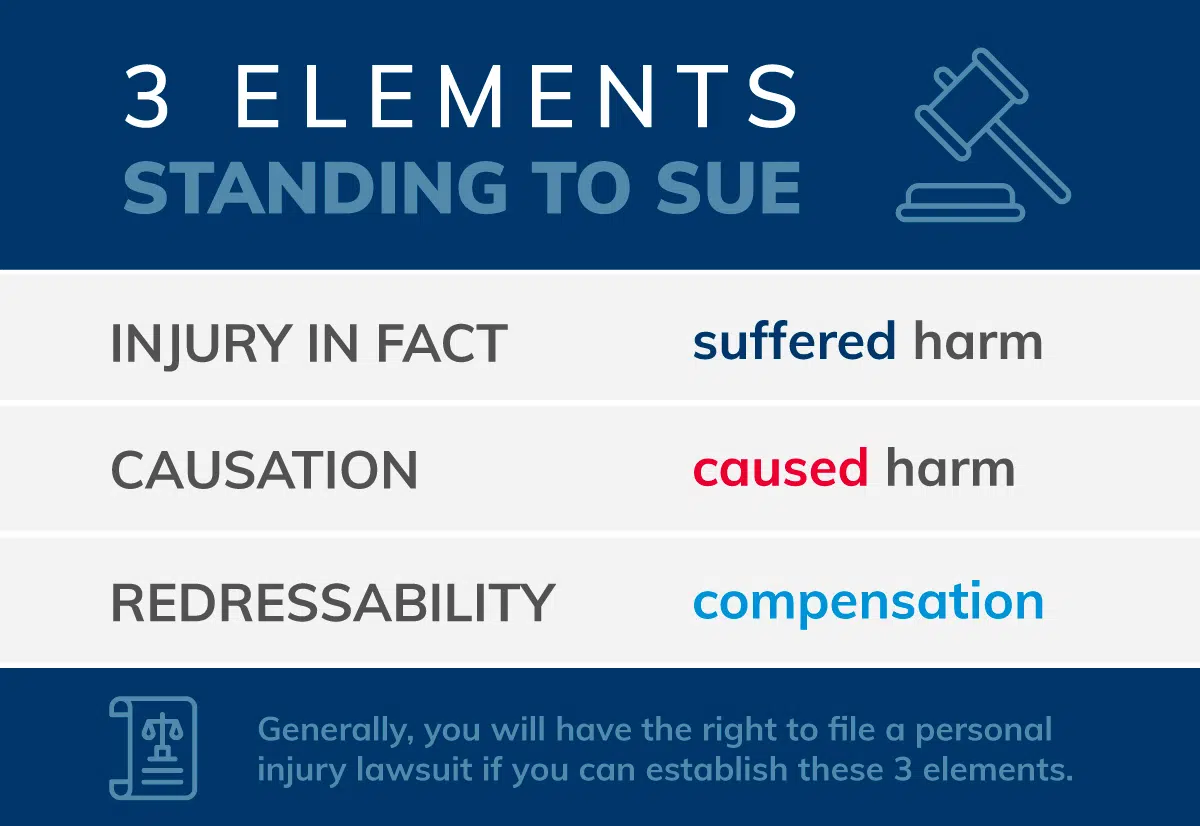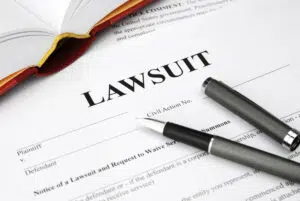Alejandro Figueroa | July 19, 2021 | Personal Injury

Before discussing the elements of standing to sue, it helps to understand what is meant by standing. The issue is addressed in the United States Constitution for federal cases. However, states have enacted laws and issued rulings that impact how standing is determined in cases in state court.
What is Standing?

Standing is a legal concept. It refers to the capacity of a person to file a lawsuit. Florida laws require that a person have a “stake” or interest in the outcome of the case.
For example, individuals who have been injured in an automobile accident, because of a defective product, or as a result of another personal injury incident generally have standing to file a lawsuit.
They have an interest in the outcome of the case because the outcome determines whether they receive compensation for their injuries and damages.
The Three Elements of Standing to Sue
When determining whether you have the standing to sue, Florida courts examine three elements:
Injury in Fact
To sue another party, you must have suffered an actual injury. The injury may be a physical injury, such as injuries sustained in a construction accident. However, it can also include monetary losses, such as lost wages, property damage, and medical bills.
You must have sustained the injury before filing the lawsuit. Standing is not granted for hypothetical claims or the risk of being injured. The injury must be “real” and provable through evidence.
Causation
The court does not decide whether the defendant is responsible for your injuries and damages when considering causation. Instead, the judge merely views the evidence in the pleadings to determine whether there is a reasonable likelihood of a causal link between the defendant’s behavior and your injuries.
The court will examine if you would have sustained your injuries had it not been for the other party’s conduct. If there is no link between your injuries and the defendant’s conduct, you might not have the standing to file a claim or lawsuit.
Redressability
Redressability is concerned with whether the judicial system can provide relief to the person filing the lawsuit. The plaintiff must have a personal stake in the outcome of the legal matter. In an accident case, the court cannot undo the injuries sustained by the plaintiff. However, it can hold the defendant financially liable for the plaintiff’s damages.
Damages in a personal injury case may include economic and non-economic damages such as:
- The victim’s past, present, and future medical expenses
- The cost of personal care or long-term nursing home care
- The victim’s past, present, and future loss of wages, bonuses, salary, benefits, commissions, and other forms of income
- The pain and suffering experienced by the victim, including physical discomfort, mental anguish, and emotional distress
- Disfigurement and scarring caused by the injury
- Permanent impairments and disabilities
- A reduction in future earning potential
- Loss of enjoyment of life and quality of life
The jury determines the value of damages if the jurors find that the defendant is responsible for the plaintiff’s injuries and damages.
What Does Standing To Sue Mean?

Standing to sue refers to having the right to file a lawsuit. The plaintiff must provide sufficient evidence to convince the jury that the defendant’s conduct directly resulted in the plaintiff’s injuries and damages.
If the plaintiff does not prove the legal elements of their case, the jury may decide in favor of the defendant.
Having the standing to sue does not mean that a plaintiff automatically wins the case. In other words, standing does not mean the defendant is guilty.
Examples of Standing to Sue in a Personal Injury Case
Now that we know the 3 elements of standing to sue, let’s take a look at some examples of who has standing to file a lawsuit in the context of personal injury law.
Example 1
John hurts his back when he slips and falls on a slick floor near a broken freezer at a neighborhood grocery store.
John would likely have standing to sue because (a) he suffered an injury, (b) there’s a good chance the store was negligent for not cleaning the floor, warning him, or fixing the freezer, and (c) compensation would help to make him financially whole.
Example 2
Devon experiences internal bleeding and extreme pain after having a medical device implanted by a surgeon at the local hospital. It’s discovered that the device wasn’t inserted correctly, pointing to medical negligence.
She would likely have standing to sue the surgeon because she’s suffered identifiable harm, evidence suggests her doctor was negligent, and damages for her physical and emotional suffering would benefit her.
Example 3
Sam’s best friend is killed in a car accident when he’s struck head-on by a drunk driver. Sam would not have standing to sue for his friend’s wrongful death.
Even though he may have suffered extreme emotional distress and the driver is clearly liable, Sam can’t satisfy the redressability requirement. Since Sam isn’t a family member, he’s not permitted to seek damages in a wrongful death action. There is no way for the civil justice system to compensate Sam for his tragic loss.
On the other hand, his best friend’s closest family members may meet the requirements of standing to sue.
Note that having standing doesn’t mean that you’ll win your case. The nuances of standing and successful litigation of a claim can be complicated. If you suspect you have a case, but aren’t sure, it’s important to discuss the specifics of your situation with a qualified lawyer.
Can Someone Have a Case and Lack Standing to Sue?
Yes, there are cases in which a person meets the three requirements for standing to sue but cannot file the lawsuit on their own behalf.
For example, a minor may meet all of the requirements to file a lawsuit for a personal injury. However, by law, minors do not have the standing to file a lawsuit. Instead, a parent, guardian, or court-appointed representative must file the lawsuit on behalf of the minor.
The same rule applies in cases involving adults with a mental incapacitation that prevents them from making decisions for themselves. If a person holds a general durable power of attorney, that person might have standing to file a lawsuit on behalf of the incapacitated person. The court might also appoint a conservator to file the lawsuit on behalf of the incapacitated adult.
Standing is an affirmative defense to a personal injury lawsuit. The defendant must raise the issue of standing if they want the dismiss the case for lack of standing. Failing to raise the issue before a trial could result in waiving the defense.
The best way to know whether you have standing to file a personal injury lawsuit is to ask an attorney. An attorney can evaluate your situation and explain your legal rights and options for receiving compensation for damages.
Contact Our Personal Injury Law Firm in Tampa, FL
If you’ve been injured in an accident in Tampa, FL, and need legal help, contact our Tampa personal injury lawyers at Catania & Catania Injury Lawyers to schedule a free consultation.
Catania & Catania Injury Lawyers
Bank of America Plaza
101 E Kennedy Blvd #2400
Tampa, FL 33602
(813) 222-8656
We also provide legal assistance throughout the Tampa Bay Area including Clearwater, St. Petersburg, Sarasota, and Bradenton.

